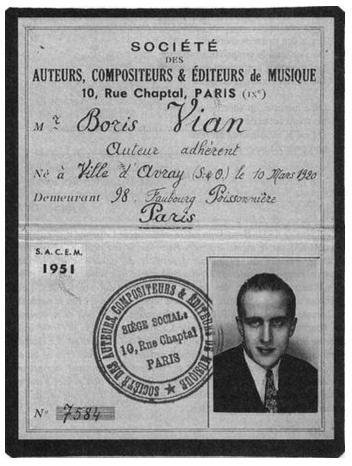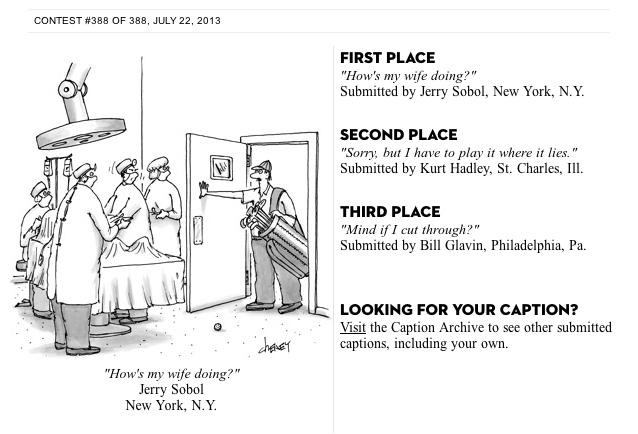Paper Ruins Garbage Scam We've All Been Running This Year
“In fiscal year 2012, some 4,185 tickets were handed out to residents who used the city’s trash cans as their personal dumpsters, but in the just-ended fiscal 2013, only 922 were given out. The Sanitation Department says fewer monitors were patrolling for perpetrators, as enforcement officers were transferred to traffic duty for weeks after Hurricane Sandy.”
There Is Nothing To Do Today
This is it, the null week of summer, the therapist’s vacation, the day in which all goals are revealed to be empty, the end of meals and the endless snack, the day that reveals that the point is pointless. There is absolutely nothing to do and nowhere to go, so don’t do anything. Buy yourself something pointless, like a sandwich or a pet or a trinket. Read half a book and then put it down forever. Certainly don’t get dressed.
To Tlön: Let's Invade Reality
by Jacob Mikanowski

On November 24, 1948, Vernon Sullivan disappeared. Two years earlier he had caused a scandal in Paris when Editions du Scorpion published his first novel, I Spit on Your Graves. Sullivan was black, but passed as white. He was tired of reading about “good blacks” in American novels, “the type that whites affectionately pat on the back” and he wanted to write something that portrayed a harder world, the one he knew from life. His book was brutal, sexually explicit, and racially taboo. Its protagonist is Lee Anderson, a blond, blue-eyed black man who arrives in the Midwestern town of Buckton intent on avenging the lynching of his baby brother. He goes to work in the local bookstore and befriends the neighborhood teens. Eventually they introduce him to two wealthy white girls — sisters — whom he will seduce, rape and murder.
Sullivan knew he couldn’t publish I Spit on Your Graves in America, “that chosen land of puritans…alcoholics and sermonizers,” but he couldn’t have been prepared for its reception in France. For the first few months, the book sold poorly. Then, a right-wing group called the Association of Social and Moral Action singled it out as an example of the new postwar decadence and sought to have it banned. I Spit on Your Graves became the first book to be prosecuted for obscenity since Madame Bovary. While the case was heading to trial, events took a dark turn. A woman was found murdered in a cheap hotel near the Gare Montparnasse. Her lover, a married, middle-aged salesman had strangled her, but before killing himself he underlined some of the more violent passages in I Spit — including one in which Lee describes the feeling of strangling his girlfriend. Police investigators found the book next to her body. The tabloids picked up the news. Sales soared.
Sullivan’s book was a hit. It was the single best-selling book of 1947, ahead of de Beauvoir, ahead of Sartre, ahead of Camus. People wanted to meet him. The press wanted to talk to him. He was also the plaintiff in a civil suit that could carry a heavy fine or even lead to time in jail. He had to appear in court, which was tricky, because Vernon Sullivan didn’t exist. He was the invention of his “translator,” Boris Vian, a jazz trumpeter, songwriter, poet, engineer and cabaret star.

Vian was the quintessential Left Bank scenester. He played with Juliette Greco, wrote for Les Temps Modernes, and hosted Duke Ellington when he was in Paris. He introduced Miles Davis to Louis Malle and shared a mistress with Sartre. Vian had a bad heart; he knew from childhood that he was going to die young. His favorite things were thrillers and jazz. He wrote I Spit on Your Graves on a dare. A friend of his was launching a series of crime novels and wanted something that could compete with the editions of Chandler and Cain put out by the famous Série Noire. He asked Vian what book he should translate, but Vian instead decided to secretly write one himself and pretend that he had translated it from the l’américain. It took him two weeks.
By the time the court caught up to him, Vian had moved on to other things. In 1946 and 1947 he published two novels under his own name, Vercoquin and the Plankton and his masterpiece, Froth on the Daydream (L’Écume des Jours — also translated as Foam of the Daze, and now a movie by Michel Gondry). Both are experimental, caroming, oulipo-esque larks full of wordplay and absurdity. They were the kind of work he wanted to be known for, as opposed to the work he was known for, if under a different name. But by this point, he was trapped in an identity he no longer desired. The prosecutor at his trial offered to acquit Vian of offending public decency, if he could demonstrate that he was a genius. He declined. He accepted his fifteen-day jail sentence without complaint (the sentence was immediately commuted, but he still had to pay a stiff fine) and admitted that I Spit on Your Graves “hardly deserves attention, from a literary viewpoint.”
But is that true? On the surface, yes. As fiction, I Spit on Your Graves is pretty second-rate, a series of poorly-drawn vignettes propelled forward by a puerile thirst for sex and mayhem. The prose is amateurish, the sex both coy and gross, and the general attitude misogynist. The characters are either ciphers or props, moving through a cardboard-cutout Midwestern anywhere cobbled together from pulp thrillers and film stills. Odd details betray Vian’s unfamiliarity with America, as when Lee’s bobbysoxer friends gorge themselves on canned chicken in aspic (aspic?!) after an orgy: “Bill, Dick and Nicholas were in their shirtsleeves and covered in sauce. Lou had an enormous mayonnaise stain down her dress.” Sometimes, Vian’s own obsessions come through unexpectedly, like when Lee lectures his friends on the origins of African American popular song, or when he complains to the reader about the difficulty of writing a literary bestseller.
I Spit on Your Graves was a provocation and a prank, and the public swallowed it whole. On the face of it, the novel doesn’t work as literature. Its ethics are, well, questionable. Even though Vian stood resolutely on the side of racial justice, the politics of a white Frenchman writing in the guise of a black American describing a black man posing as a white man are obviously problematic, opening the possibility of a kind of dizzying inverse double-blackface. But the book’s very flaws are what make it hard to ignore. It goes down like a shot of cheap whisky, with a jaggedness that keeps you reading and a bitterness that lingers on the tongue.
Despite himself, Vian managed to crystallize something that was in the air in Paris in 1946. The film historian James Naremore singles the novel out as one of the birthplaces of noir. For him, it’s a distillation of the dark, new sensibility and an emblem of its fascination with sexual violence and racial otherness. Twenty years later, James Baldwin saw a novel that was deeply flawed and even pornographic in its treatment of black sexuality but one which also got at something real about French feelings after the war, their “terrified wonder about Americans” and unease at the disturbing conundrum of the black G.I. To Baldwin, I Spit wasn’t exploitation; it came from an authentic sense of anguish, and it managed to communicate “rage and pain” that “Vian (almost alone) was able to hear.”
Vian was inspired to write the book after he read an article by Herbert Asbury, the crime-reporter-slash-fantasist who wrote Gangs of New York (and inspired a chapter in Borges’ Universal History of Infamy). The article was about passing, concealing black identity beneath a white facade. It’s clear how the article affected the creation of Lee Anderson. Maybe in creating Vernon Sullivan, Vian wanted to make a fictional author who could pass as real.
Vian’s genius was in creating the writer; the novel itself is an afterthought. I love the thought of Sullivan wandering Paris for a few years, granted life by means of a literary hoax. Sullivan’s existence in between fiction and fact is what’s really compelling about Vian’s book. Despite being fraud, he’s the realest thing about it. For two or three years, as far as everyone was concerned, he really was alive.

Ulisse Aldrovandi, “Historia serpentum et draconum,” 1640
Naturally enough, the French have a term for this type of shadowy existence between the fictional and the real. Vernon Sullivan was a pataphor, an “extended metaphor that creates its own context,” or as its inventor Pablo Lopez put it, “that which occurs when a lizard’s tail has grown so long it breaks off and grows a new lizard.” The controversy around I Spit on Your Graves opens onto a host of issues surrounding race, representation, mimicry and deception, but it’s that new lizard — the reality catapulted into being by the depth of the fiction sustaining it — that really gets my heart racing. In part, because there is something thrilling about all frauds, but especially about frauds that threaten to upend and overwhelm their makers. But mostly because granting reality to Vernon Sullivan, even if it was the limited reality of a quasi-fictional golem or a para-literary Frankenstein’s monster, strikes right at the heart of what we normally think of as the proper relationship between literature and the world.
For the past couple of years, the debate about the respective roles of fiction and non-fiction has been dominated by what might be called the reality wars. On one side of there is the great James Wood, standing behind the august tradition of realist fiction. Realism, claims Wood, is not a genre but an essential, underlying mode. It is the way fiction fulfills its true purpose: deploying artifice in service of truth, and that truth is something Wood calls (borrowing from Virginia Woolf) lifeness. And there is the true quarry of literature: the hypostatized, italicized, real.
On the other side of the debate is David Shields. In Reality Hunger, he argues for a continuous blurring of the boundary between the real and the invented, the fictional and the non-fictional. Let’s let the memoir and the fragment coexist with the short story and the dispatch. Let’s do away with categories and abolish false distinctions and wait for a hundred new forms to burst out of the shiny chrysalis that’s created when you forget about the difference between self and world. It’s a beautiful, liberating thought, which carries with it the promise of knocking the novel off of its unearned throne and putting an end to literary criticism as a kind of wine-tasting connoisseurship, with its endless appraisal of finely-wrought similes and characters modeled in the round. But that isn’t really at the core of what he is saying. What Shields really seems to want isn’t a new way for fiction to relate to reality, but more ways for it to speak directly to his own experience. In short, it’s not new kinds of books he’s after, but more books about himself and people like him.
So there’s the choice, as it stands now — between the low road of the pragmatically intimate wisdom-laden, aphorism-spouting lightly-fictionalized-bust-mostly-real memoir, and the high road of the literary novel still on its centuries-long quest to grab “lifeness… life on the page” and bottle it up like a perfume in a container of fancy prose. But what if there was another way? What if fiction used all the weapons at its disposal to deceive, inveigle, mislead and persuade us that things that are fake are real? What if it treated reality as the target of a guerilla war, a staging ground for infiltration complete with double agents, tiger traps and sleeper cells?
What would happen then? Would fiction lose its ethical core? Would reality slowly crumble, like a termite eaten-house? Would it even work?

Taprobana, “Ptolemy’s Geography,” 1492
Many years ago, I came across a book called The Queer Dutchman in a used bookstore. It is the diary of Jan Svilt, a sailor in the Dutch East India Company fleet at the beginning of the 18th century. In the course of one voyage he was found guilty of buggery and marooned on an island in the middle of the Atlantic as punishment. Over the course of the book, Svilt sails around the Cape of Good Hope, remembers his brutal childhood in Holland and idyllic days in Jakarta, and narrates his struggle to survive on the inhospitable rock to which he’s been banished, before succumbing to thirst and starvation. The whole thing is vivid, alive and quite moving, especially the parts in which Svilt records memories of his lover, a beautiful Indonesian youth named Bandino, who teaches him Sufi poetry as they conduct their beautiful, doomed, affair.
Except, it isn’t true. Or, not the best parts at least. There really was a sailor who was marooned on Ascension Island, and he really did write a diary, found by an English crew after he died. It was later published, in an abridged, translated and possibly corrupt form. But the book I read wasn’t that. The Queer Dutchman is a work of historical fiction by Peter Agnos (a pseudonym for one Cy Adler), cleverly disguised as a scholarly reprint through the addition of various learned appendices on island geology and 18th century seafaring.
It’s a very persuasive fraud. It was convincing enough to work its way into a few scholarly papers, but obscure enough that hardly anyone noticed. It certainly fooled me. It was only uncovered by a scholar of Dutch naval history, who realized that the dates of the voyages didn’t match the manifest recorded in an 18th century logbook. When I found out the truth I was upset at having been duped, and more than a little puzzled. After all, there didn’t seem to be a motive. Why did Agnos go to the trouble of falsifying this little-known, though remarkable story, especially with so little to gain in terms of recognition or personal glory? The whole thing is baffling. Unless, maybe, it was part of a larger scheme to doctor the historical record in a thousand microscopic ways in order to populate it surreptitiously with stories of illicit love.

It’s an uncanny feeling, to fall into a trap like that. There’s a story by Jorge Luis Borges called “Tlön, Uqbar, Orbis Tertius,” which captures the exhilaration and eeriness of it better than anything I’ve ever come across. In it, a fictional world called Tlön gradually invades our reality and replaces it. The story starts off simply. Borges and his friend Bioy Casares are hanging out in a Buenos Aires apartment, talking about mirrors and narrative (as one does), when Casares remembers something about an ancient kingdom called Uqbar. When they try to look it up in an encyclopedia, it isn’t there, but when Casares goes home, he finds an entry about it in his own copy of the same encyclopedia. It explains, among other things, “that the literature of Uqbar is a literature of fantasy, and that its epics and legends never referred to reality but rather to the two imaginary realms of Mle’khnas and Tlön.” The two friends go to the library to find out more about the real country, Uqbar, and its fake twins, Mle’khnas and Tlön, but they come up with nothing.
A short time later, an English friend of Borges’ dies. His personal effects are found to contain a single volume of a complete encyclopedia devoted to Tlön, its geography, mythology, linguistics, and peculiar idealist philosophy. Finally, its secret is revealed: Tlön is the work of a secret society that had been working for centuries to devise a country. In America, they found a wealthy patron who laughed at the modesty of their ambition, and told them that what they ought to invent a planet instead. The volume was the first step in Tlön’s revelation. Later, strange objects described in the encyclopedia start appearing in the real world — a compass here, a weird metallic cone there. A full blueprint for the imaginary realm surfaces in a Memphis warehouse. At this point, reality begins to cave in. People begin to study Tlön’s biology and mathematics. Tlönian history is taught in schools, and Tlönian languages begin to replace Earth’s. As the story ends, the whole world is spellbound by Tlön, and is about to be disintegrated by it.
Borges imagined the takeover of reality as a nightmare. Having seen the world consumed by the “intoxicating symmetries” of Ideology in the thirties and forties, he had every right to. But what if we took at Tlön as a guidebook instead of a warning? More and more, memoirs feel spent and novels exhausted. Why not try a third way? Call it Tlön, after Borges’ imaginary planet. Tlön isn’t really a genre, but a set of strategies. They can be hard to pin down. It helps to draw a little road map first. Turn right at the realist novel. Pass fantasy and science fiction and any form of fictional world-building on the left (not that there’s anything wrong with world-building — I’ve spent too much time thinking about Hobbit architecture and Westerosi politics to ever think so). Focus instead on works that give up on depicting reality in favor of undermining it.

Adam Ryder, from “Selections From the Joint Photographic Survey”
These can be books that take the form of fake encyclopedias, like Roberto Bolaño’s Nazi Literature of the Americas or Borges’ Universal History of Infamy, or that use elaborate stories about lost or recovered manuscripts as their frame, as in Jan Potocki’s Manuscript Found in Saragossa, Cervantes’ Don Quixote, or Nabokov’s Pale Fire. Historical fantasies don’t really work, but alternate histories do, like the Luther Blissett/Wu Ming books, Yael Bartana’s videos of the Jewish return to Poland or Annio da Viterbo’s gonzo rewriting of European prehistory. Secret histories, like the Procopius or Eugène Sue or Greil Marcus’ Lipstick Traces are even better. Some pranks — the Kensington Runestone, the Ossian Poems, War of the Worlds. Mockumentaries, especially when they’re played really straight, like in F is for Fake or Peter Greenaway’s The Falls.
You can get to Tlön by treating fiction as if it was real, and giving it the consistency of historical fact. David Thomson does that in his great, overlooked novel Suspects. So does a lot of Peter Carey, especially My Life as a Fake and Jack Maggs. I think Christian Marclay’s installation The Clock counts here, too. It’s made up of clocks in movies, one for each minute of the day. Unfolding in real-time, Marclay’s work seems to suggest that the movies form their own world, running along parallel to our own; the clock is really a window.
Some invented worlds work too, but only when their creators believe them. Take for example the fairy portraits of Richard Dadd, drawn in an asylum, or Henry Darger’s monumental history of the child slave rebellion. To the work of Tlön, insanity is no hindrance, and megalomania an asset.

Bas Princen, “Shopping mall parking lot, Dubai,” 2009, courtesy Van Kranendonk Gallery
Certain kinds of religious revelation might qualify, especially when they deal with lost continents or vanished races — see Ignatius Donnelly, Constantine Rafinesque, and Augustus LePlongeon. Pseudepigraphy, writing done in the voice and guise of religious figures — Saint Paul chatting up Seneca; Jesus fighting aerial duels with Judas (who wins) — counts as a whole. So do a range of hoaxes: Psalmanazar the Formosan, a Frenchman who convinced Samuel Johnson and the rest of Europe that he was Taiwanese; Edmund Backhouse, who (among other things) created a fictional eunuch’s diary to prop up his scurrilous story of the last days of Manchu rule. Laura Albert as JT LeRoy. Forgeries work too, as long as they aren’t done in the name of self-interest or malice (so no Hitler Diaries or Protocols of the Elders of Zion, but perhaps Beatrice Sparks’ Go Ask Alice, and definitely actress Joan Lowell’s invented 1929 memoir of a life at sea, The Cradle of the Deep).
In fact, absence of self interest and of ego seems to me a general rule for Tlönian art. The work of Tlön might not be ethical, but it has an ethics: however much its deceptions might betray or confuse, they must serve the work itself, and not its maker. The author cannot be the protagonist. Lies are allowed, but they shouldn’t be told with an eye toward self-promotion or embroidery (no Jennifer Laucks, Jonah Lehrers or Jayson Blairs). The goal, ideally, is to create something and let it dissolve in the bloodstream of the culture like a virus, and to do this without acknowledgment or compensation. You subordinate yourself to a creation, and then you get out of its way.
Vian did many things after his deception was revealed. Vian wrote books under his own name, played in bands, acted in cabarets, staged plays, divorced, remarried. But Vernon Sullivan never left him. Sullivan deprived his plays of an audience and his other novels of readers. For a while he tried using Sullivan as a pseudonym and writing novels under his name, but it didn’t stick. Neither did any of his other pseudonyms (he had at least thirty-seven). In 1959, against his wishes and without his participation, someone made a movie out of I Spit on Your Graves. It was a travesty with obviously fake locales and a French actor in the lead. Vian went to the opening screening. Ten minutes in, he stood up and shouted, “These guys are supposed to be American? My ass!” He then sat back down and died of the heart attack. Face to face with his creation, and like a true son of Tlön, Vian went down with the ship.

Boris Vian’s tomb in Ville-d’Avray. In accordance with his wishes, nothing on it identifies him.
Jacob Mikanowski writes about art, books and Europe east of Berlin. Bas Princen photograph copyright the artist and courtesy Van Kranendonk gallery; Adam Ryder photograph copyright the artist. Selections From The Joint Photographic Survey is a self-published, limited-edition available here.
"Nothing's Shocking" Is 25
25 years ago today, Jane’s Addiction released their first studio album, and for the brief window of time before, uh, “Seattle,” they were the alternative to the hair-heavy metal-medium sound of the day. That is probably hard to remember, since it was 25 years ago. 25 years. There are people you work with right now who just turned 25. And here you are talking about some record that is younger than they are. Is death far off? No, no it is not. Anyway, the lyrics to “Up the Beach” remain my favorite Perry Farrell poetry of all, but I tend to like the simpler things in life. This record is still pretty good! Although I’m sure you young people today with all your hoppy-hop and screechy robot noises find it quaint and unlistenable. Eh, someday it’ll happen to you too, assuming we don’t all die in a fire before your generation has the chance to get old, which, given the way things are going, is not the most sound of assumptions. Where was I? I forget.
14 Things To Do This Weekend
Today’s podcast is sponsored by Audible. From this link right here you may obtain a 30-day free trial of Audible and a free audiobook. It’ll give you something to listen to as you drive yourself crazy with regret!
Witness A Same-Sex Wedding Aboard An Air New Zealand Flight
by Awl Sponsors
On the very same day that New Zealand’s same-sex marriage law came into effect, Air New Zealand gave Lynley and Ally the wedding of a lifetime. After being together for over 13 years, this couple was ecstatic about celebrating their marriage on board an Air New Zealand plane in front of their children, friends and family. Special guest Jesse Tyler Ferguson was also there to witness their vows at 30,000 feet.
For more photos and footage, visit Air New Zealand on Facebook.
Happy National Duck Out For A Drink Day

Most days you show up to work in spite of the fact that you know it’s going to make you want to die. You do your job as best you can, quietly but diligently, keeping your complaints to yourself and negotiating the thousand little minefields that strew themselves about the arena of any human endeavor in which deadlines and hierarchies are the twin engines that fuel the drive forward. You keep your head down to the extent that you know you are there to get things done, not make it The You Show, and if you’re desperately waiting for the moment the day ends and you can finally carve out a little time for yourself, that still doesn’t detract from the effort you expend to do what you’re there to do. Then you go home, wanting to die, and make the best of the few hours they give you until you need to do it all again. You work hard, you don’t call attention to yourself, and you give it as much of yourself as you have. You, in short, deserve some kind of prize. Unfortunately, that’s not the way the world works. But there is one day a year where your toil is acknowledged, however briefly. That’s right: the Founding Fathers, in George Washington’s famous “Fuck This Shit” section of The Federalist Papers (later withdrawn due to a great deal of internecine dispute which we do not have the space to get into here), established August 25th as “the day upon which the noble worker shall sneake off to quickly imbibe whilft in the midft of his labors,” or, as it has come to be known, National Duck Out For A Drink Day. The 25th falls on a Sunday this year, meaning that today’s the day we observe the holiday in which you take time for yourself to sneak out to a nearby tavern and knock back a couple beers, slam a few shots, or, depending on how long you think you can linger, treat yourself to a few jumbo cocktails. Be sure to bring a couple co-workers with you: National Duck Out For A Drink Day is even more enjoyable if you think about it as a team-building exercise that you’ve put together on your own, where the only “trust falls” are actual stumbles. Remember, if you’re out at the bar during work hours it’s like they’re paying you to drink! Go do us proud, workers of America! (Unless your job involves creating some kind of syphilis vaccine, in which case what you’re doing is way too important for you to take even a moment away from it.) If you manage to make it back and are still in any condition to type, tell us your stories in the comments. And make sure somebody brings some mints for when you stagger up the stairs on your return. (Take the stairs, it’ll sober you up a little.) Have a great National Duck Out For A Drink Day! Who deserves it more than you?
Photo by StockLite, via Shutterstock
The Cuckold Surgeon's Heinous Revenge
by Willy Staley

The winning submission to The New Yorker’s cartoon caption contest #388, by Jerry Sobol, of New York, N.Y., appears to the lay reader, or the person in need of glasses, to be a simple joke about how careless middle-aged men can be about their spouses. A closer read reveals a dark, Cheeveresque narrative penned by Sobol, who likely harbors retrograde opinions about women’s place in the world that would horrify the average New Yorker reader.
A chinless man carrying a bag of golf clubs and wearing golf clothing, has burst into a surgery, perhaps while attempting to locate a stray shot (whether he is playing golf within the hospital or nearby is immaterial, though both, we must point out, seem equally absurd). The surgeon and his support staff look on, dumbfounded. The man asks: “How’s my wife doing?”
Classic. Famously described as “a good walk spoiled,” golf is so much more than that to a certain breed of American men. It is an affair without the affair. A long-running poker game without the disgusting cigars (well…). The sport may have become more inclusive since the Augusta National Club invited its first black member to join way back in 1990 — or, I suppose the year right before that — but rest assured that few men are happy when their wives take it up. It is a five-hour ticket away from all familial duties, which goes a long way to explaining why so many people spend so much money playing a game that is so consistently vexing and humiliating.
So the lay cartoon reader, whether male or female, hardly has to think about this — which is “the idea” of a New Yorker cartoon, after all, a quick interstitial chuckle, to give you a break from the emotionally draining narrative about a Turkish restaurant that makes Turkish people cry, or whatever. Clearly a sandbagging, Polish-joke-telling, hideous-swing-swinging scumbag golfer has taken the opportunity presented by his wife’s second breast augmentation to catch a quick round. Har-har. Whattadick! That men who golf are careless toward their wives is such a fat and juicy trope-fruit on the trope-ula tree in your average New Yorker reader’s backyard that the branch hangs so low the neighbor’s cat routinely paws at it while writhing around on its back in the way that cats do. It’s so goddamned obvious that we’d be rubes to not assume it this what it could only be: a diversion, sleight of hand — a mere layer of gloss over the hideousness that lies beneath it.
But no. Take a look at the area surrounding the surgeon’s mask.
Even a child would recognize these lines to be the universal cartoon sign for movement, indicating that the surgeon’s mask is moving, from which we can infer that he is speaking. Once you realize that the surgeon is asking the golfer how his wife is doing — and not the other way around — the scene takes on a depraved air.
Seeing past Sobol’s trickery, the story writes itself: the Surgeon works surgeon’s hours (erratic), making surgeon’s pay (handsome), enough that his wife doesn’t have to work, but, this being 2013, she’s not sure she wants kids either, and so she takes up a hobby — on a whim, golf. Part boredom, part loneliness, part just honest-to-God not-giving-a-shit, she starts sleeping with the pro. It’s not even that she finds him attractive, it’s his un-Surgeon-ness that appeals to her. You know how these things go: one second he’s helping her with her backstroke, hands around her waist, like that one scene in Tin Cup (1996), the next they’re always finding reasons to book the (private) area with the high-tech swing analysis equipment.
This goes on for some time, rather discreetly until it hits an inevitable snag. The surgeon gets called in for what he thinks will be an all-night thing — another texting-while-driving case where a kid got all intertwined with a roll of chicken wire from the flatbed that had been in the other lane — but the patient died before the Surgeon even had a chance to operate. He came home to the sound of the back door slamming, and found one of those screw-in plastic golf spikes and a combination divot-remover/yardage finder left behind on the rear patio. Why are you home so soon? his wife asked, stepping out of the shower, her hair barely wet. His beeper goes off before he can say a thing: 911. The other guy, the guy driving the chicken-wire truck, he just showed up.
Apologies if that is all a bit obvious. It’s just that some people are terribly bad at inferring what has happened just “before” the events of a single-panel cartoon unfold.
The Surgeon, furious, fools both the golf pro and the hospital staff into allowing the confrontation we witness to happen. (If you must know: by telling Golf Pro and the staff that it was the Golf Pro’s younger brother upon which he was operating. Distraught, Golf Pro was in such a hurry, he forgot to leave his clubs behind.) As Golf Pro bursts in, Surgeon’s entire staff looks up him — ruling out the possibility, which might cross a less-capable reader’s mind, that the Golf Pro is an apparition brought on by jealous rage — distracting them from the patient’s surgery. “How’s my wife doing?” says the Surgeon, scalpel in hand, chill in his voice.
Golf Pro hardly has time to reach for his six iron. We all know how it ends for the truck driver.
One cannot witness a morality play this heavy-handed without wondering about the author’s intent. Thematically, it’s practically an homage to the midnight movie favorite The Room (2003), about an affable but severely mentally handicapped Moldovan man driven to an unintentionally humorous suicide by his scheming jezebel of a bride-to-be. Just as viewers would be right to wonder if Tommy Wiseau, The Room’s auteur, harbors a deep-seated hatred of women, we must wonder the same about Sobol. Why else would he subject us to this absurd tragedy unless he wanted to teach us some lesson about how he believes women, liberated as they are now from their traditional responsibilities, bring men low?
This column typically assumes that New Yorker readership understands, or at least intuits, the deeper meanings behind the Caption Contest winners, but if that were the case here, it would be an ugly glimpse into their collective psyche. No, it’s clear the wool was pulled over both the readership and even, perhaps, the editors’ eyes: all the finalists to the contest are submissions that assume the Golfer is speaking. This widespread misreading of the cartoon concerns me, as it should any scholar of single-panel cartoons, but it also offers relief, of a sort. No, not all subscribers to The New Yorker harbor a misogynist agenda. It’s just Sobol, that magnificent trickster.
Willy Staley contributes to Shitty New Yorker Cartoon Captions.
New York City to Newark to New York City, August 21, 2013

★ The descending gibbous moon, in the ever-so-slightly paling sky, cast a jaundiced gaze on the previous night’s decision-making. When the sun came, it brought disgusting heat, under a white-blue sky. The air conditioning on the 1 train was not able to stop the sweat from having rushed for the train. Out the windows of the upper deck of a New Jersey Transit car, in the 1:05 out of Penn Station, a highway ramp shone brown in the distance. The train decelerated so smoothly into the airport station that the stop was only noticeable, to the distracted mind, when it started moving again, too late. At Elizabeth, passengers waited in the cool of the ticket office for the trains they intended to take. It was OK on the platform if you didn’t move much; all of visible Elizabeth seemed to be trying to lay low. The 1:47 was on time, the interior dangerously soothing after the heat. But there was the airport stop, and the AirTrain with its windows less grimly tinted than the regular train’s, and the airplanes parked almost precisely atop their own shadows. On the ride home, in the livery car, the toddler kept saying Tunnel! in the deep shade of the overpasses.
